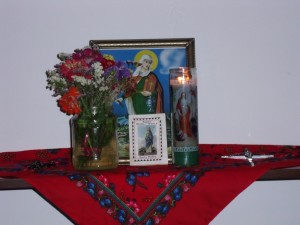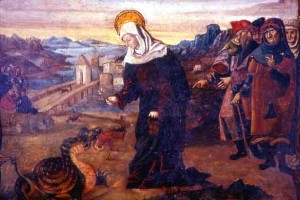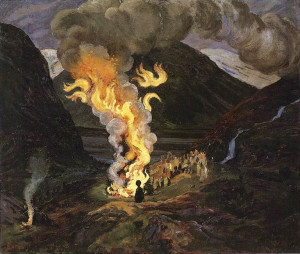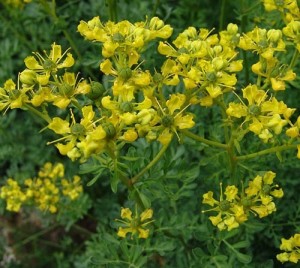Peace be with you, my friends! September is here already and I am looking forward to the coming weeks of Autumn, my favorite time of year. This season is so special to spiritual workers of all traditions since it is when the earth gives us all of her gifts and the spiritual energy just courses through the air. This time of year culminates in the celebration of Halloween, All Saints Day and All Souls Day, known in Voodoo as Fete Ghede. In both Wiccan and Voodoo circles, this holiday is seen as a celebration of the New Year, the harvest and a communion with our ancestors, saints and spirits on the other side, principles that are important to all spiritual people and which we try to obverse and honor on a daily basis.
Autumn is special to spiritual workers of all traditions.
 Last night was another important spiritual holiday, The Festival of the Hungry Ghosts, which is Asian in origin and not a traditional observance in Voodoo, but I have incorporated it into my yearly repertoire of spiritual holidays. It is a time to honor spirits of ancestors and spirit guides on the other side and also to pray for those forgotten souls who have nobody left on earth to honor them. There are legends in Taiwan and mainland China about Hungry Ghosts who appear on rural roadsides and deserted corners of cities on this night looking for offerings of food or spirit money. Anytime we make offerings or pray for the dead we perform an act of great mercy for which the spirits are truly thankful and they in turn offer us blessings and protection here on Earth. Last night, I placed offerings of flour dumplings, rice, cornmeal cake, wine, water, brandy and spirit money on my altar. After presenting the offerings and asking their blessings, I burned the spirit money outside on my balcony. Today the house is filled with a powerful yet peaceful energy!
Last night was another important spiritual holiday, The Festival of the Hungry Ghosts, which is Asian in origin and not a traditional observance in Voodoo, but I have incorporated it into my yearly repertoire of spiritual holidays. It is a time to honor spirits of ancestors and spirit guides on the other side and also to pray for those forgotten souls who have nobody left on earth to honor them. There are legends in Taiwan and mainland China about Hungry Ghosts who appear on rural roadsides and deserted corners of cities on this night looking for offerings of food or spirit money. Anytime we make offerings or pray for the dead we perform an act of great mercy for which the spirits are truly thankful and they in turn offer us blessings and protection here on Earth. Last night, I placed offerings of flour dumplings, rice, cornmeal cake, wine, water, brandy and spirit money on my altar. After presenting the offerings and asking their blessings, I burned the spirit money outside on my balcony. Today the house is filled with a powerful yet peaceful energy!
On the 30th of September there is another Asian holiday that I observe, the Mid-Autumn Lunar Festival, which is a festival of the harvest honoring the goddess Chang’e, the goddess of longevity that lives on the moon. It is also a time to spend with family members and prepare large banquets. I will blog more about this festival later in September.
 On another note, I have a new addition to my family! A two-month-old Siamese kitten name Vlad who came to live with me on Tuesday of last week. Cats, as we know, are very spiritual animals and can easily see the spirits that are often invisible to the human eye. In Thailand, once called Siam, Siamese cats were kept by monks and the royal family and were believed to chase away evil spirits, ward off bad luck and draw good luck! These beautiful cats were even put in charge of guarding royal treasure. In the future, I plan to write a blog about “lucky” animals from different cultures throughout the world which include cats, goldfish, roosters, canaries and more.
On another note, I have a new addition to my family! A two-month-old Siamese kitten name Vlad who came to live with me on Tuesday of last week. Cats, as we know, are very spiritual animals and can easily see the spirits that are often invisible to the human eye. In Thailand, once called Siam, Siamese cats were kept by monks and the royal family and were believed to chase away evil spirits, ward off bad luck and draw good luck! These beautiful cats were even put in charge of guarding royal treasure. In the future, I plan to write a blog about “lucky” animals from different cultures throughout the world which include cats, goldfish, roosters, canaries and more.
I hope you have enjoyed this post and that you have many wonderful activities planned for the upcoming Autumn weeks-the most fabulous time of year!
Rue Money Magic
Peace be with you my friends! These are busy times of me as I am in the middle of looking for a new apartment, preparing for the Festival of the Hungry Ghosts at the very end of this month, starting a new program to become a licensed psychotherapist and cognitive behavioral therapist and of course my usual readings and services. I have been thinking about what areas of Voodoo and Magick I have not deeply explored on this blog, and I've realized that I have not spoken much about herbal magic which is a fundamental part of Voodoo and many other spiritual traditions.
Herbal magic is a fundamental part of Voodoo & many other spiritual traditions
So, today I would like to share a traditional money spell using a powerful herb called Rue. Rue has many magical properties including protection and cleansing, but it is most highly celebrated as a bringer of prosperity. I hope you enjoy the following spell and if you give it a try, please share you experiences with me.
Rue is a powerful herb native to southern Europe and is a staple in traditional Italian magic, also known as Stregheria, and in various Afro-Caribbean magical traditions. Rue has many uses-protection, love, luck and even revenge all fall under the dominion of this mighty plant. You can find rue growing wild in many places in North America and it is also widely available in farmers markets. The following is a recipe for a rue wash that is meant to bring luck and prosperity to your home and family. It is highly popular in Puerto Rican and Cuban popular magic. Rue is slightly toxic so be careful not to ingest or wash your body with the rue water. Let it only touch floors and inanimate objects.
Rue Floor Wash for Luck and Prosperity
Handfuls of fresh or dried rue
Water for boiling
A green candle
A Bible
Fill a pot with water and bring in to a roaring boil.
Toss in the rue and allow it to boil exactly seven minutes.
Remove the pot from the fire and set it to cool. Light the green candle next to the cooling pot of rue liquid and hold your right hand over the liquid while praying the 23rd Psalm aloud.
When you are finished reciting the psalm, say in a loud authoritative voice “May this blessed liquid bring wealth, prosperity and protection to me and my family. Amen! So be it! So it shall be!”
Allow the candle to burn out and the liquid to cool completely. Strain it and save it in bottles for future use.
You may add a little of the liquid to your detergent water when you wash the floors or you can sprinkle small amounts of the liquid around your home or office every Friday and during the new moon to bring wealth and success.
Saint Martha’s Day
Peace be with you, my friends! I hope you all are enjoying the summer. Last Sunday was Saint Martha’s feast day. As you may have read in previous posts, I am a big devotee to this particular saint and she has worked many miracles in my life and in the lives of others that I know.
Saint Martha's day is celebrated every July 29th.
 I made a service to her with a candle and an offering of flowers. I will be drying the flowers that have now been infused with Saint Martha’s powerful energy to use in charms and potions in the future.
I made a service to her with a candle and an offering of flowers. I will be drying the flowers that have now been infused with Saint Martha’s powerful energy to use in charms and potions in the future.
I have written a much more extensive article about Saint Martha herself, you can read it here.
At the end of this month, August 31st, we have another important spiritual holiday, The Feast of the Hungry Ghosts. This year, the holiday happens to fall on a blue moon, which will make the energy on that night all the more powerful. I of course will be writing a blog entry about The Hungry Ghosts later this month and will post photos of my own offerings on that night.
As always I wish you peace, happiness and the sweetest of blessings!
Saint Martha
Peace be with you my friends! The summer so far and been stiflingly hot and I have been doing little more than going to work, doing my spell work at home and then relaxing with the air conditioner turned on full blast! My goals for later in the summer and into fall are to get back to a normal writing discipline both for my blog and a book on psychic vampires and how to rid ourselves of them that I have been intending to write for quite some time now. I also plan on making Voodoo related pieces of art. Today I wanted to share a little about Saint Martha, one of my personal favorites, on whose help I have called several times with tremendous results. I have blogged briefly about her in the past, but wish to do so again since she has been incredibly helpful to me and I want to spread devotion to her as much as possible.
There are two versions of Saint Martha found in Voodoo and other Afro-Caribbean religious systems.
 There are two versions of Saint Martha found in Voodoo and other Afro-Caribbean religious systems, mainly espiritismo and Las 21 Divisiones from the Dominican Republic. It is important to remember that they are not separate entities, but just different manifestations of the same spiritual being which vary due to people’s culture perceptions.
There are two versions of Saint Martha found in Voodoo and other Afro-Caribbean religious systems, mainly espiritismo and Las 21 Divisiones from the Dominican Republic. It is important to remember that they are not separate entities, but just different manifestations of the same spiritual being which vary due to people’s culture perceptions.
According to biblical tradition, Saint Martha was the sister of Mary of Bethany and Saint Lazarus, whom Christ raised from the dead. In one story from the gospel of Luke, Martha receives Jesus into her home and serves him food while he preaches to her sister Mary who sits at his feet. After the crucifixion, according to medieval legend, Martha, Mary and Lazarus travel to the south of France where they preach the Gospel and help spread Jesus’s message of peace and love. She was also recorded as having rebuked and tamed a dragon-like monster called the Tarasque by sprinkling holy water on it and invoking the name of God. I personally love Saint Martha because her example shows us that we can receive greatness by doing simple things as long as they are done with love and faith.
Another version of Saint Martha that appears quite often in Afro-Caribbean iconography is that of a light skinned African woman with two large snakes wrapped around her body. The snakes could be a new world version of the Tarasque from medieval French imagery. In Puerto Rico and the Dominican Republic, her devotees believe that she ends her snakes out on your behalf to eat away negativity and obstacles that hold you back in life. She is also invoked quite often in love spells so much so that she has come to be called Santa Marta Dominadora “The Dominator” due to her ability to make people do your will in matters of love. Again, I believe that the European and African Saint Marthas are one in the same, but she has just taken on a different form to endear herself to her devotees who themselves are largely of mixed African and European descent.
There is an old tradition of lighting a candle and reciting a prayer to Saint Martha on nine consecutive Tuesdays. This devotion is known as the Nine Tuesdays of Saint Martha. I have used this novena on several occasions and have never been let down. I have not always gotten what I’ve asked for, but each time my request was refused, something better came along! I can say from personal experience that Saint Martha does look after her devotees! I am happy to share the prayer I’ve used to invoke Saint Martha and I hope you put it use as well. When your petition is granted, it is customary to thank her by making a small donation to charity or a church and of course spreading devotion to her by telling others about her. Here is the prayer:
Saint Martha,
I resort to thy aid and protection.
As proof of my affection and faith,
I offer thee this light,
which I shall burn every Tuesday.
Comfort me in all my difficulties
and through the great favors thou didst enjoy
when the Savior was lodged in thy house,
intercede for my family,
that we be provided for in our necessities.
I ask of thee, Saint Martha,
to overcome all difficulties
as thou didst overcome the dragon
which thou hadst at thy feet.
In the name of the Father
and of the Son and of the Holy Spirit.
Amen
I do hope you try this prayer to Saint Martha and if you do, please share your experiences with me! Until next time I wish you peace, love and blessings!
That Time of Year Again: Saint John’s Eve
Peace be with you, my friends! I just wanted to take this time to make a quick post and acknowledge the longest day of the year! This time of year is particularly sacred to many different religions and magical practices. Wiccans conduct special rituals for the solstice and in many cultures of northern Europe people light bonfires on this night, a tradition that traces its roots to ancient rituals meant to confer protection from elves, gnomes and other trickster spirits that were at their most powerful on this night.
Bonfires lit on this night are a popular tradition.
In Voodoo Saint John’s Eve, the 23rd-24th of June, is considered to be the most powerful night of the year for doing any kind of spiritual work. I have been planning this years St. John’s service since the end of April and have been incredibly busy. I am happy to re-share an article about this particular night and some of the Voodoo traditions associated with it. I wish you all and happy and magical Saint John’s Eve.
Voodoo in New Orleans is much a solitary practice as compared to the religion in Haiti, but there is an exception: The Feast of Saint John the Baptist, which falls on the 24th of June. The feast day is celebrated in Haiti, and indeed throughout the Catholic world, but nowhere as intensely as in New Orleans. This feast is particularly popular in Francophone countries. In rural France, people light bonfires on Saint John’s Night and in Quebec, on the morning of the feast, an old superstition dictates that one collect drops of dew from leaves and grass to sprinkle around the house for good luck. Also, some believe that when applied to the face, this water will bless a person with a youthful appearance. In New Orleans, the Feast of Saint John is observed most intensely by Voodooists, perhaps as a remnant of a time when it was fêted more fervently by the general population. It is believed that on this night, the veil between the spirit world and the physical world is virtually nonexistent and communion with the ancestors, saints and lwa can be easily achieved. Curiously, a similar belief in the Galicia region of Spain holds that that the souls in Purgatory can return to Earth on that same night, since the mystical dividing veil is lifted. On the eve of Saint John’s Day, every Voodooist is expected to attend a communal drumming session in which members of the local community make food offerings to the ancestors and saints, and this is one of the rare occasions when animal sacrifices, usually chickens, are made by the presiding Voodoo Queen.. All Voodoo queens and doctors, if they are to remain in good standing with the spirits and the local community, are expected to attend a service on this night. The following is a description of the events that occur on this sacred night. The character names are fictitious and represent no persons living of dead, but the details of the ceremony are accurate.
A Saint John’s Eve Short Story
 Immediately following Easter, Evangeline carefully plans the sequence of events for the Fête de Saint Jean Baptiste. This year she will serve as presiding priestess over the ceremony, a role to which she was nominated by last year’s mistress of ceremonies, Muriel, her friend and fellow Voodoo Queen. Evangeline contacts all of her friends, family and acquaintances and inquires as to whether she can expect their presence on Saint John’s Eve. In the following weeks, she visits those planning to attend and collects donations to defray the cost of the ceremony. Then she secures a location for the gathering on the Bayou Saint John, where Marie Laveau conducted her infamous ceremonies, and obtains the necessary permits from the city. Then the drummers are hired and Evangeline buys the food and live animals necessary to make offerings to the spirits and to be consumed by the assembly.
Immediately following Easter, Evangeline carefully plans the sequence of events for the Fête de Saint Jean Baptiste. This year she will serve as presiding priestess over the ceremony, a role to which she was nominated by last year’s mistress of ceremonies, Muriel, her friend and fellow Voodoo Queen. Evangeline contacts all of her friends, family and acquaintances and inquires as to whether she can expect their presence on Saint John’s Eve. In the following weeks, she visits those planning to attend and collects donations to defray the cost of the ceremony. Then she secures a location for the gathering on the Bayou Saint John, where Marie Laveau conducted her infamous ceremonies, and obtains the necessary permits from the city. Then the drummers are hired and Evangeline buys the food and live animals necessary to make offerings to the spirits and to be consumed by the assembly.
The day before the ceremony, Evangeline and two close friends, Renee and Stacey, meet to prepare the food for the following evening. Renee and Stacey prepare such Southern and Creole classics as collard greens and fatback, spoon bread, hopping john, shrimp Creole, dirty rice and pulled pork, all to be consumed by the congregation. Only Evangeline, however, is permitted to prepare the ritual offerings for the spirits. She takes great care to make sure that no a single grain of salt comes into contact with the food offerings. She makes white rice, roasted pork spiced with black and cayenne pepper, grits, and a dish called “amala”, which is a slimly concoctions of chopped okra stewed with corn meal resulting a slippery mess, a taste and texture unappetizing to the human palate, but absolutely decadent to the spirit world. Evangeline thanks her friends and they leave with all the food that has been prepared, and it will be their responsibility to bring the offerings to the gathering the following night. All those expected to attend the service take special herbal baths at home the night before to rid themselves of negativity and neutralize their spiritual vibrations as to be able to fully receive the blessings of the saints and spirits.
On the afternoon of Saint John’s Eve, Evangeline’s friends arrive at the predetermined site and set up the wood pile that will become a massive bonfire. They arrange tables with the previously prepared food as the sacrificial chickens await their imminent death in cages resting on the ground. The drummers arrive shortly after and set up their musical equipment and in the late afternoon the guests start to arrive and socialize while they anticipate the presence of the mistress of ceremonies who is due to arrive at sundown.
When the last amber rays of summer sunlight retreat behind the tree tops, Evangeline arrives. She parks her car a short distance down the street, preferring to make her entrance on foot. Seeing Evangeline in the distance coming toward them, the guests for a semicircle and she takes her place in the center. She stands there for a moment in silence, dressed in white from head to foot resting her weight on the ribbon and bell bedecked baguette des morts. Then, she bangs the stick three times of the ground and makes the opening prayer, “in the name of the Father, and of the Son, and of the Holy Spirit.” The congregation makes the sign of the cross and responds “Amen.” Raising her outstretched palms toward Heaven, she cries, “faith, hope and charity,” the three virtues by which Voodooists are compelled to live. The congregation once again responds with a resounding “Amen” and with that, the ceremony has begun.
Renee and Stacey, Evangeline’s designated helpers from the previous day, come to meet her in the center of the circle. They are to hand her all supplies that she will need throughout the evening. Renee hands her a small vial of holy water that she herself had taken from the baptismal fount at her parish church earlier that day. While Evangeline sprinkles the ground around the soon-to-be ceremonial pyre the congregation softly recites the opening prayers in unison: The Our Father, the Hail Mary and the Apostles’ Creed, in that exact order. Stacey takes Evangeline’s baguette des morts and respectfully holds it while Evangeline tends to the preparation of the fire. The wood having been previously dowsed with kerosene will light without trouble, but Evangeline must first sprinkled the mound with a variety of dried herbs, some graveyard dirt and a few drops of holy water before it is torched. Meanwhile, Renee and Stacey trace a cross in the dirt next to the fire pit using a mixture of cornmeal, ground white eggshells, dust from a church and dirt from a graveyard and a crossroads. When Evangeline finishes consecrating the fire pit, she turns her attention to the cross that Stacey and Renee have prepared. She touches the ground three times and makes the sign of the cross. Then, from a pitcher, she spills water three times on the ground and says “pou mo-ye,” for the dead. Then Renee and Stacey bring her the dishes of food she personally prepared the previous day. With the dishes neatly placed at the four points of the cross, Evangeline declares “mange sec pou mo-ye,” dry eating for the dead. Voodoo pactitioners refer to food offerings as “mange sec” to distinguish them from animal sacrifices in which case the spilt blood is the offering, not the animal itself. The spirits and saints take the offerings of food and spilled blood and convert them into pure energy that is then used to grant their petitions and bring good luck and prosperity into their lives.
With the offerings all laid out, Evangeline takes a sip of rum and then spits in out onto the dirt floor altar in front of her. Then she places a small white taper in each dish of food. When the last taper is lighted, before placing at the center of the cross, Evangeline uses it to set the ceremonial pyre ablaze. The congregation claps and cheers and the drummers begin to play. The rest of the night is a pleasant combination of religious rituals and a friendly party atmosphere. The guests dance and eat traditional Creole specialties as well as drink beer and rum drinks. Throughout the course of the evening, they sing songs in Creole, French and English to call down the saints and ancestors. The spirits make take possession of whomever they choose, not just Evangeline. When a spirit or lwa touches a person and takes control of his body, the drumming stops and the congregation waits in silence for this person to speak. He or she comes forward and speaks to those assembled and gives instructions for spiritual workings to be carried out. The spirit, through the medium, will let the people know if the evil eye or any hexes have been placed on them. If this is found to be true, Evangeline immediately cleanses them of the evil eye or unclean spirits by passing a live chicken over their head and touching it to the palms and backs of their hands. Then, she snaps the chicken’s necks and slits its throat with a sharp knife, squeezing the animal until the last drop of blood is spilled on the ground. The chicken is then disposed of, since it cannot be eaten because the negative influence once on the person has been passed to the chicken.
As the night progresses, more spirits mount the guests and people ask favors of them and lay flowers and dollar bills at their feet to thank them for favors granted in the previous year. This night is one of the few occasions in New Orleans Voodoo where spirit possession takes place, and it is considered an honor to be touched by a spirit. As dawn approaches, Evangeline calls all the guests to the form a circle once again. She calls down her personal spirit guide who indicates the person who is to serve as next years presiding Vooodoo Queen at the fête de Saint Jean Baptiste. It is Stacey. Stacey readily agrees and they seal the new appointment with a kiss on each cheek. Renee retrieves Evangeline’s baguette des morts, which Evangeline once again bangs three times of the ground exclaiming, “faith, hope and charity.” “Amen,” responds the congregation. She strikes three more blows to the earth and prayers, “in the name of the Father, and of the Son, and of the Holy Spirit.” Another magnificent “Amen” rises up from the crowd. They all make the sign of the cross and head for home. The ceremony is over. Only Evangeline remains. She gathers the offerings of food and places them in the center of a cotton cloth, which she then ties up into a neat bundle. She collects the dollar bills strewn about the grounds, which she will donate later that day to a church or charitable organization. As she drives off, she is sure to take a different route than the one she used to get there, as not to let any bad spirits follow her home and ruin her luck. Quickly stopping at a crossroads, she leaves the cloth bundle with the food offerings for the spirits. She drives to her church where Renee and Stacey are waiting for her, and they attend an early morning mass together to celebrate the Feast of Saint John the Baptist.
While Evangeline, Stacey and Renee are fictitious characters, the rituals described in the above story are true and accurate. Other traditions may exist in various communities, since there is no set liturgy as in established churches, but in the Voodoo tradition, the feast of Saint John remains of the most important feasts of the year and is universally observed wherever Voodoo is practiced, be it in Haiti, New Orleans, Martinique or in Afro-Francophone communities in New York and Quebec. Nowhere, however is the tradition more intensely adhered to than in New Orleans. Perhaps this is due to the fact that in Louisiana, as opposed to the other locations mentioned, Francophone Creoles and Voodooists are an ever increasing minority, and the fact that enough people choose to practice this beautiful faith and gather each year to give thanks to God, the ancestors and the saints and be together as a community of believers is cause for celebration. In short, the fact that a people who have been told for centuries by the white Anglo establishment that their culture, language and faith are inferior have been able to hang onto the language spoken by their ancestors who toiled in the cane fields and practice a faith both brought over on slave ships and enriched by the prayers once sung in Latin from high church altars is in and of itself a miracle! The Voodoo faith, like those who profess it, is a Creole religion, and the concept of Creole is simple: A syllogism of drastically different elements melded to form a new and living reality. It is a religion of power and survival.
